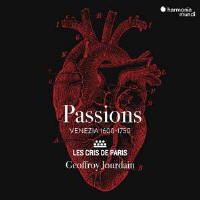Texte paru dans: / Appeared in:
Harmonia Mundi |
|
|
Reviewer: J.
F. Weber The subtitle is “Venice, 1600–1750,” but the composers range from Giovanni Gabrieli (b. 1555) to Antonio Lotti (d. 1740), so the timespan is rounded off. This large vocal ensemble with nine players chooses seven examples from the obvious leading light, Claudio Monteverdi, including a couple of excerpts from larger works, three pieces from Selva morale e spirituale, and the 1620 Adoramus te Christe. Three familiar settings of Lotti’s Crucifixus are included, as Martin Neary did on Miserere (Fanfare 19:6). Tarquinio Merula (1595–1665) is included but not the less famous and earlier Venetian, Claudio Merulo (1533–1604), saving us some confusion.
Jourdain
calls attention to the placement of two 16-voice pieces in succession, the
latest (Caldara’s) and the earliest (Gabrieli’s) of all the works on the
disc. But Gabrieli’s is polychoral, while Caldara writes for one choir. He
also refers to the teacher–pupil connections among Venetian composers, even
mentioning several not represented here. The overarching theme, of course,
is passions, taken in multiple meanings, the affetti (human
passions), the Passion of Christ, and his own passion for Venetian music.
It’s the kind of thematic program that successfully unites a disparate
collection of musical works. Well done. | |
|
|
|
|
|
|
|
Cliquez l'un ou l'autre
bouton pour découvrir bien d'autres critiques de CD |
|




